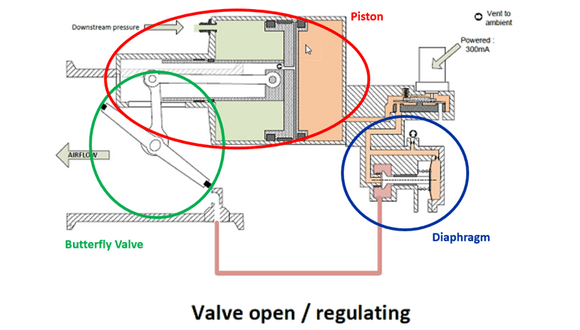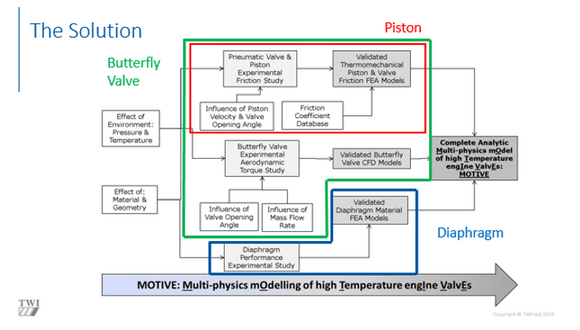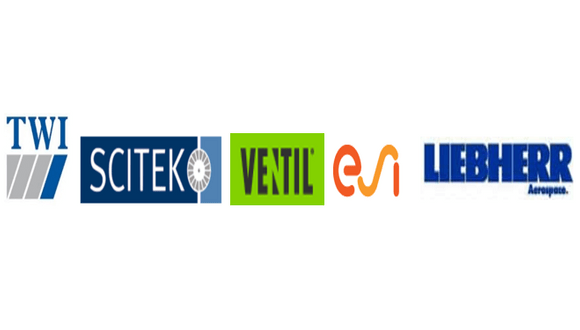Fri, 20 August, 2021
MOTIVE is a 48-month Horizon 2020 project about aero-engine bleed valves, which is due to reach completion in February 2022.
Several partner companies have contributed to this project along with TWI - they are Scitek, Ventil and ESI in conjunction with the topic manager of the project, Liebherr.
Motive is an acronym standing for, ‘Multi-physics Model of High Temperature Engine Valves.’ Aero-engine bleed air systems include components that deliver and control compressed engine bleed air from the main engine or auxiliary power unit to other downstream systems. These systems include cabin air conditioning, engine start, and wing and engine ice removal. The design and integration of aircraft pneumatic bleed air valves is becoming ever more challenging due to the aggressive environment in which the valves must operate close to the aircraft engine. High temperatures, high pressures and non-homogenous air flow all contribute to the performance of pneumatic engine valves and their actuators.
Motive characterises the three main components of a bleed valve as the piston, the butterfly valve and the diaphragm. Pneumatic butterfly valves are typically actuated by a piston for use in severe engine environments. Piston movement is driven by a pressure difference applied to both sides of the piston. To enable the piston to extend and retract, whilst preserving this pressure difference, a sealing ring is required. In a similar fashion to the piston sealing ring, a sealing ring on the butterfly valve isolates the upstream and downstream flows when the valve disc is rotated to the fully closed position. Design and integration of these sealing rings is critical to ensuring efficient operation of the piston actuator and valve butterfly.

The pressure difference required by a pneumatic valve can be achieved using a deformable diaphragm membrane. As a deformable component, the diaphragm will contribute to mechanical equilibrium of the actuator piston. It is therefore necessary to determine the performance of the diaphragm under different operational conditions (temperatures and pressures) for different diaphragm geometries and for different materials.
According to Boeing data collected over a two-year period, the pneumatic bleed system accounted for nearly 7% of all schedule interruptions for 747-400 and 767 airplanes. Design optimisation of pneumatic valves and their associated actuation mechanisms is therefore critical to keep costly unscheduled delays to a minimum. Pneumatic valves and their actuation systems can be optimised in-situ, however the associated costs are substantial. Being able to predict valve performance during the design phase would reduce these costs considerably.
The aerospace industry therefore needs a predictive multi-physics model which can be used to optimise the design and predict the performance of engine valve design, reducing the incidents of engine bleed air valve malfunction. Such a model currently does not exist. The primary objective of MOTIVE is to satisfy this need.

The overall concept underpinning the MOTIVE project is the use of targeted experimental bench tests to separately validate numerical models based on the three key physical domains involved in engine valve operation - thermal physics, mechanical physics and fluid dynamics. Having developed a thorough understanding through experimental measurement and numerical simulation of the key elementary physical phenomena which describe valve and piston operation, a complete analytical multi-physics model for high temperature engine valves will be delivered. This mathematical model will be informed and guided by the numerical modelling activities.
The MOTIVE project will, for the first time, create an industry disruptive virtual prototyping framework for optimising valve and actuator piston design, which can be easily integrated into multi-physics modelling software such as MODELICA. This will maximise the functionality and predictively of the multi-physics modelling solution and enable the immediate exploitation of that model for optimisation of subsequent valve designs, reducing the incidents of engine bleed air valve malfunction.
The MOTIVE project has received funding from the European Union's Horizon 2020 research and innovation programme under grant agreement No 785530
